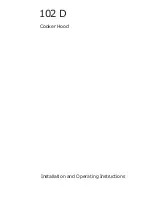
Installation Instructions
English | 10 |
Electrical Requirements
The unit requires a 120V AC, 60Hz. 15A branch circuit.
The hood should only be connected to a dedicated circuit
(with ground) that has been installed according to relevant
regulations.
Check your local building codes for proper method of ins-
tallation. In the U.S., if there are no applicable local codes,
this unit should be installed in accordance with the National
Electric Code ANSI/NFPA No. 70, Current Issue. In Canada,
installation must be in accordance with the CAN 1- B149.1
and .2 - Installation Codes for Gas Burning Appliances and/
or local codes.
The appliance must be grounded. In the event of an elec-
trical short circuit, grounding reduces the risk of electric
shock by providing a wire that allows the electric current to
escape.
WARNING
The appliance must be grounded.
Electrical Data on the Data Rating Label
Data, including the model and serial number, is located
on the product data rating label inside the appliance,
visible after removal of the ilter frame.
Ductwork Preparation
Discharge Direction
The exhaust air is discharged upwards through a duct.
The hood can be mounted only with a vertical discharge.
Ducting Recommendations
Proper performance is dependent upon proper ducting.
Local building codes may require the use of make-up air
systems when using ducted ventilation systems greater than
speciied cubic feet per minute (CFM) of air movement.
The speciied CFM varies from locale to locale. It is the
responsibility of the owner and the installer to determine if
additional requirements and/or standards apply to speciic
installations.
DO NOT USE FLEXIBLE DUCT
; it creates back pressure/
air turbulence and reduces performance. Always use metal
ductwork.
Always install a metal vent cover where the ductwork exits
the house. Hood must be vented to the outside of building
only.
COLD WEATHER
installations should have an additional
backdraft damper installed to minimize backward cold air
low and a nonmetallic thermal break to minimize conduc
-
tion of outside temperatures as part of the ductwork. The
damper should be on the cold air side of the thermal break.
The break should be as close as possible to where the duc-
ting enters the heated portion of the house.
MAKE-UP AIR:
Local building codes may require the use of
make-up air systems when using ducted ventilation systems
greater than speciied CFM of air movement.
The speciied CFM varies from locale to locale. It is the
responsibility of the owner and the installer to determine if
additional requirements and/or standards apply to speciic
installations.
For safety reasons, ducting should vent directly outdoors
(not into an attic, underneath the house, into the garage or
into any enclosed space).
THERMADOR
®
recommends not exceeding 50 equivalent
length (ft) (15.24 m) of duct.
Keep duct runs as short and straight as possible.
Elbows and transitions ittings reduce air low eficiency.
Back to back elbows and “S” turns give very poor delivery
and are not recommended.
A short straight length of duct at the inlet of a remote
blower gives the best delivery.
Hoods are supplied with a 8” (203 mm) round transition. A
locally supplied transition is required for other sizes.
Use “Equivalent Duct Lengths for Commonly Used Transi-
tions” on page 11 to compute permissible lengths for duct
runs to outdoors.








































